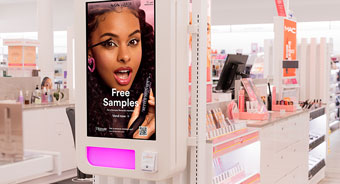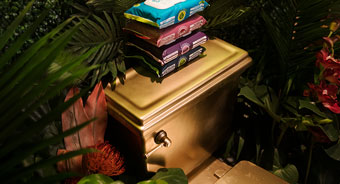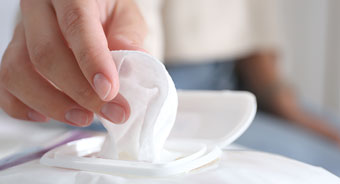Here are some of the key topics that have shaped 2023 and beyond.
Period Care Access
Legislative efforts across the globe are increasing period care access in public restrooms. In 2020, Scotland became the first country to require that all public bathrooms be equipped with feminine care products, and this month government workplaces in Canada will provide free menstrual care products. This move has been replicated by at least five states and even more municipalities throughout the U.S. Additionally, at least 20 states require free period care products in schools. In January 2022, Ann Arbor, MI, became the first U.S. city to mandate that feminine hygiene products be available in public restrooms, regardless of gender designation, a move already being replicated.In the wake of these legislative efforts, companies doing business in the away-from-home period care market have ramped up efforts to create products that are suitable for free and public distribution. One of these is Egal Pads whose Roll on a Pad product comprises 40 individually packaged sanitary pads that can be dispensed via a standard toilet paper roll in public bathrooms. The pads lack wings and other bells and whistles found in the consumer market but offer an emergency solution to menstruators.

SOS and Ulta Beauty have partnered to offer complimentary Rael period care products in stores.
“No one should be without easy access to necessary period products and disposal solutions when they are needed,” says ISSA director of Government Affairs John Nothdurft. “This campaign aims to build on bipartisan legislation that has been passed in more than a half-dozen states to make period products more readily available in places such as schools and prisons. We also will help educate and engage facility managers, cleaning industry leaders, and the general public about the benefits of increasing access to period products and disposal solutions.”
ISSA’s efforts include multi-faceted advocacy and lobbying in support of public policies to increase access to period products, dispensers and disposal solutions in away-from-home venues. The increased access to menstrual care products, dispensers, and disposal solutions will significantly reduce period poverty, school absenteeism, and protect the health and well-being of cleaning workers and the public.Hospeco has been involved in the away-from-home menstrual care market for about 40 years but saw growth significantly ramp up five years ago, around the time it began its“Period Partner” initiative, advocating strongly for free menstrual care products in all public restrooms. Efforts included the creation of a standalone website that acts as a source of information and advocacy materials including legislative progress.
Along with advocacy efforts, Hospeco has ramped up its product development in the category. In 2022, the company expanded its Gards brand of fem care products for vending use with the introduction of Enviro Gards Organic Maxi Pads Vend Pack. These products feature pesticide-free, 100% organic cotton topsheet; a compostable box; and an innovative, biodegradable and compostable bioplastic barrier film and wrapper. Enviro Gards Pads are chlorine-free, dioxin-free and fragrance-free. Additionally, the company expanded on its no-touch toilet seat cover dispenser by introducing no-touch menstrual care product dispensers and no-touch personal care waste receptacles.
SOS, a Boston, MA-based developer of dispensing technology for public restrooms affirmed its commitment to improving period care access through a recent partnership with Rael, the 360 holistic feminine and beauty company focused on clean period care, intimate care and skincare. The two companies have pledged to give away 200,000 tampons and pads at all of SOS’ 100+ machines throughout the next year in an effort to increase access to essential personal care products in high-traffic public locations. The partnership is backed by a six-figure investment from Rael and is the largest direct brand investment to date for SOS.
“Every woman has experienced a moment when she needed a tampon and one was nowhere to be found, a frustrating feeling only exacerbated when in a public space like a sporting arena or office building,” says Susanna Twarog, co-founder and co-CEO of SOS, whose machines are in high traffic areas including Rockefeller Center and Fenway Park. “We believe that all people deserve access to period care products wherever, whenever, and our partnership with Rael helps us bring that mission to fruition as we make their organic, effective pads and tampons available for free in all of our machines.”
In October, SOS announced an exclusive partnership with Ulta Beauty, the nation’s largest beauty retailer, to usher in a new era of in-store product discovery driven by digital innovation. The pilot will elevate Ulta Beauty’s in-store sampling program and test its first-ever digital in-store advertising program to deepen customer engagement and drive growth for brand partners. The SOS machines will also offer complimentary Rael period care products for Ulta Beauty guests, conveniently providing more access to necessities in stores.
Tax-Free Initiatives
Last month, the U.K. Parliament announced it would abolish tax on all period pants by next fall. Other period products such as pads and tampons have been exempt since 2021 in the U.K.Meanwhile, U.S. states have continued to take similar measures on not only period products but also baby diapers with the motivation that these products are necessities, not luxuries. The most recent state to adopt such a measure is Texas, which in September became the 25th state to eliminate sales tax on feminine hygiene products, also sometimes referred to as the “pink tax” or “tampon tax.”
Although the legislation was finalized in June, efforts to eliminate the pink tax in Texas began last year when several state lawmakers voiced support for the proposal.
Additional states considering a measure include Arizona, Georgia, Hawaii, Indiana, Kansas, Kentucky, Mississippi, North Dakota, South Carolina, South Dakota and West Virginia.
Reusable Hygiene Continues Evolution
The market for reusable or washable hygiene products has become somewhat saturated in recent years as newcomers look to replicate the success of brands like Thinx and Modibodi, which were been acquired by Kimberly-Clark and Essity, respectively, showing the viability of this market. As reusable underwear products continue to gain attention, from both retailers and consumers, as well as multinational companies with their investment dollars, companies are facing significant pricing pressure. While the market for reusable incontinence items continues to grow steadily, at about 6.3% per year, according to Future Market Insights, current formats face a lot of competition.
Knix recently launched a line of Leakproof Shapewear.
Unlike, disposable or washable absorbent underwear, the incorporation of a replaceable high performance absorbent liner allows for easier changes after insult because the wearer can slip the pad in and out without removing the complete garment. This allows to dispose urine in smaller charges enabling the use of more or less regular underwear even for people suffering from medium incontinence. It also creates significantly less waste than other formats. Also, unlike washable formats, the liner contains SAP securely locking the urine and can better manage odor control. pelzGROUP has also filed patents for a flushable absorbent strip only using plant-based materials which will solve the issue of disposing the used article and turn the amount of plastic waste to zero.
“You cannot enter this washable market with a me too product, which you can only do on price. You have to enter this market on function offering a real USP,” says Henning Röttger, head of business development. “We are looking at value-based pricing, not cost-based pricing—because the second has really challenged the industry limiting innovation.”
Meanwhile, Knix, which was acquired by Essity in 2022, just launched reusable Leakproof Shapewear that can absorb about 0.8 - 3 tsp of liquid, which is the equivalent of about one to three regular tampons or about one to two pantyliners.
Flushability Grows
Two decades after Kimberly-Clark’s failed launch of moist toilet tissue (MTT) in 2001, the market for flushable wipes is poised to reach $1 billion in the next several years thanks to a blend of technological advancements, consumer demand and new product introductions that have changed many people’s bathroom hygiene habits.Driving growth in the segment are changes in consumer behavior, initiated during the Coronavirus pandemic, when toilet paper shortages forced many to try wet formats. Many of these consumers have continued to use flushable wipes over traditional toilet paper products, and this has propelled the market to become a major segment within the disposable wipes market. The flushable category is projected to double in terms of tonnage between 2015 and 2025 reaching 68,900 tons and growth could even be stronger moving forward, according to industry experts.

Goodwipes offers a range of flushable wipes.
Experts predict that in the next 18 months, moist toilet tissue’s share of the North American toilet paper market should hit 10% as growth of wet products, at 28%, outpace dry products, which are growing about 10% per year.
Beyond innovation, industry collaboration focused on testing methods assessing the flushability of wipes and labeling practices within the industry have helped defend the products against legislative action. A few years ago, the industry released the Fourth edition of Flushability Guidelines (GD4) for the wipes industry. In addition to requiring more stringent flushability testing for flushable wipes to be labeled as such, these guidelines also banned the marketing of all baby wipes as flushable and required more prominent labeling on non-flushable wipes. These were developed not just by wipes professionals but through a collaboration with wastewater agencies, which had previously been combative toward the wipes market.
Amidst these collaborations, consumer demand for flushable wipes has also led to significant investment in the category. Earlier this year Hangzhou Nbond Nonwovens Co., Ltd. (NBond) and Lenzing Group partnered to facilitate the innovation and application of Lenzing’s wood-based Veocel branded lyocell fibers in flushable nonwovens products, including moist toilet tissue, feminine hygiene products and other personal hygiene product offerings. NBond, one of the earliest manufacturers to launch flushable feminine care products globally, is also among the first to use Veocel fibers in flushable feminine care products. The companies say, with a focus on innovation, the partnership will feature long-term technical and innovation support towards the development of new nonwoven fabrics using Veocel fibers at NBond’s production facilities.
Industry Defends Flushable Wipes
As the market for flushable wipes continues to grow, so have the efforts of industry members to disprove claims that these products are solely responsible for sewage problems. In accordance with California’s Proper Labeling of Wet Wipes law (AB818), the California Association of Sanitation Agencies (CASA), the Responsible Flushing Alliance (RFA), and the Association of the Nonwoven Fabrics Industry (INDA), recently partnered to conduct a sewage collection study to help determine what is clogging sewer lines and equipment across the state.So far, preliminary collection study results from two separate sites in October showed that 94% of items collected were paper (53%), wipes labeled with the “Do Not Flush” symbol (34%) and feminine hygiene products (7%). Less than 1% of items collected so far were considered to be flushable wipes. The baby wipes and other non-flushable items were found mostly fully intact.

Flushable wipes growth continues to outpace that of non-flushable wipes.
Kennedy-Jenks, an independent engineering firm, was hired to design the collection study and compile the findings in a report, due during the first half of 2024. Study parameters include pulling raw sewage samples from the headworks during peak flow times. Analysis of the items spans four days of sorting with more than 1700 items identified in the “dry season” sample alone.
Categories for items identified include all baby wipes and other non-flushable wipes outlined in the Proper Labeling of Wet Wipes law, feminine hygiene products, flushable wipes (moist toilet tissue), and non-flushable paper products (paper towels, wrappers).
Once collected, sample items are separated, identified and documented by taking a picture of each piece and writing its description in a collection logbook. A count of one item is considered any material measuring one inch or more in two dimensions.
“There is a lot of consumer confusion around what should or should not be flushed and that’s where our consumer education campaign, #FlushSmart, comes into play,” Wyss says. “We surveyed Californians about what they are flushing. The results showed that 20% mistakenly think all soft paper products can be flushed and approximately 25% think baby wipes are flushable, which is never true. Even worse, 60% self-reported they flushed something they knew they shouldn’t.”
Green Solutions for Hygiene
Creating a more circular economy within the disposable hygiene market continues to be an important topic within the nonwovens industry. Whether it’s creating a recycling system for disposable products, developing a product made of more eco-friendly materials or creating a disposal system to aid in the biodegradation of products, manufacturers are creatively offering solutions to the age-old question of how to dispose of disposables.Ontex, a leading European manufacturer of diapers and other hygiene products, has taken a leading position in alternative end-of-life solutions for disposable goods like baby diapers that includes a partnership with a local startup to aid in the recycling of use disposable diapers in Belgium as well as an examination of composting of diapers with Les Alchimistes. Together, Ontex and Les Alchimistes have set up a pilot project at Les Alchimistes’ industrial composting site with the aim of proving that composting Ontex diaper pads is possible and that waste and incineration can be reduced. Ontex is not the only hygiene producer focusing on limiting the number of diapers that end up in landfills. Procter & Gamble has established recycling operations in Italy and the Netherlands; startup Dyper has a subscription-based composting program for its diaper brand and Unicharm has developed advanced diaper recycling technology that is rolling out in Japan, where the company also has a pet products plant that make cat litter out of used diaper materials.
Battery Separators Drive Growth
Fueled by increased demand for battery operated vehicles, the market for nonwoven battery separators has emerged as a high potential market. In October, Safire Technology Group, a venture-backed company developing advanced battery safety technologies, and Glatfelter, a leading global supplier of engineered materials, announced a strategic partnership to develop a new battery separator optimized for Safire Group’s SAFe Impact Resistant Electrolyte (SAFIRE) for customers seeking increased performance and safety from their Lithium-ion (Li-ion) powered applications.
Battery separators continue to be a strong growth market for nonwovens.
“Partnering with Safire Group to develop an innovative fibrous separator for customers such as the U.S. Air Force is a fantastic opportunity,” says Boris Illetschko, senior vice president & chief operating officer for Glatfelter. “Safire Group’s innovation in battery safety complements our expertise in nonwoven solutions, enabling us to provide customers with paradigm-shifting, impact-protective Li-ion batteries.”
The partnership brings together Glatfelter’s expertise in developing innovative and sustainable nonwoven solutions with Safire Group’s revolutionary shear-thickening battery technology to offer customers safer, higher performing Li-ion powered systems.
Another company bullish about this market is Freudenberg Performance Materials, which is in the midst of a €28 million investment in gas diffusion layer capacity in Weinheim, Germany. The new capacity will better serve the European and Asian markets, with an emphasis on commercial vehicles and heavy truck areas. Freudenberg invested €10 million in new capacity, also in Weinheim, in 2020.
Berry’s Potential Sale
In September, Berry Global, the world’s largest maker of nonwovens, announced that it has initiated a formal process to evaluate strategic alternatives for its Health, Hygiene and Specialties segment (“HH&S), which could include but is not limited to the sale of the division. This announcement came amidst industry speculation that the business was on the selling block.Of course, Berry is no stranger to M&A activity. The company purchased the nonwovens business formerly known as Avintiv in 2015. Avintiv, formerly PGI Nonwovens, has grown to be the largest nonwovens producer in the world following a string of investments and acquisitions around the globe. Now, with more than $3 billion in sales, many wonder if the unit is too big to find a buyer. So the question is, will it be sold in pieces? What will it mean for the hundreds of thousands of tons of capacity controlled by Berry?
“An ongoing objective of the Berry Board is to constantly look for ways to drive long-term value for our stakeholders, which includes continuously evaluating our portfolio to ensure the company is best positioned to execute on its strategic objectives,” said Tom Salmon, Berry, former chairman and CEO. “Following an extensive analysis by the board and management team, with support from our incoming CEO Kevin Kwilinski, we have decided to explore strategic alternatives for the HH&S businesses as we continue to seek to enhance value through strategic portfolio management. As always, we will be disciplined throughout this process and will only take actions that we believe are in the best interest of the company and our stakeholders.”
Audit Program Heads to North America
In August, INDA and EDANA, the leading trade associations representing nonwovens and related industries, joined forces to implement and support the industry’s first Quality and Audit Program (QAP) in the U.S.. This joint effort will increase the reach of, and support for, the program in the North American absorbent hygiene products and wet wipes industries.Much like the harmonization of test methods years ago, this joint program has the potential to reduce complexity for both suppliers and converters of AHP and wipes. This program grew from the inefficiency of facing multiple audits from converter supplier audit programs, often assessing similar requirements, but according to differing standards.
The program went through a rigorous testing and piloting phase before being rolled out in the summer of 2022. Initially only available in Europe, the program is expanding its reach to cover Asia and the Americas.
“INDA is pleased to partner with EDANA to promote this program for the benefit and efficiency of the industry,” says Tony Fragnito, INDA president. “With this partnership, we believe QAP will become the global quality standard in the hygiene industry, thus ensuring that consumer products across the industry are of the highest quality.”
“Answering the needs of many of our members and based on the first results since its implementation in Europe just over a year ago, we are strongly convinced that QAP is a meaningful step forward for the industry. While it will still require a kind of paradigm shift, we are sure that more and more industry players from across the world will adopt the program,” says Murat Dogru, EDANA’s general manager. “I look forward to partnering with INDA to bring QAP to the North American market.”
More information is available on the EDANA website where converters and suppliers can register to take part. The program is based on a harmonized quality and hygiene standard, which facilitates an objective third-party audit. Organizations can also register to follow a training course to familiarize themselves with the standard.


